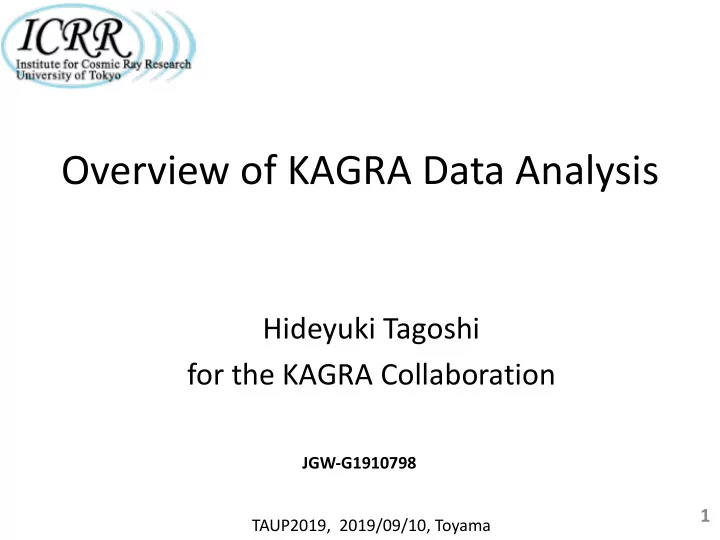

Overview of KAGRA Data Analysis Hideyuki Tagoshi for the KAGRA Collaboration JGW-G1910798 1 TAUP2019, 2019/09/10, Toyama
Anticipated observation schedule Fig. 2 to be updated 2019/4/20 LVK observation scenario 8 2
Overview of KAGRA data analysis KAGRA is planning to perform the first observation during FY2019. This is done together with LIGO-Virgo O3. New MOU between LIGO-Virgo and KAGRA are now prepared in order to perform joint observation and joint data analysis. A lot of efforts are necessary to perform start this observation in data analysis KAGRA data will be shared with LIGO-Virgo, and will be jointly analyzed. LIGO-Virgo are conducting data analysis completely jointly. We have to establish an organization for this joint data analysis. KAGRA data analysis group was reformulated in order to have a good matching with corresponding LIGO-Virgo data analysis working groups 3
KAGRA Data Analysis Working Group PI Executive KSC board Office System Data Analysis Engineering Committee Office Computing and CBC Subsystem 1 Subsystem 2 Subsystem 3 Subsystem n Software Detector Burst Characterization Continuous Calibration Waves Stochastic background Data Analysis Working Group (DAWG) 4
4 Source Categories Compact Binary Coalescence (CBC) Burst Continuous Waves (CW) Stochastic Background 5
Source Categories Individual sources known waveform unknown waveform Short Compact Binary Supernovae Coalescenses pulsar glitches duration … Long duration Pulsar (rotating NS) Stochastic background Early universe origin Astrophysical origin inflation Superposition of many sources ... Nearly isotropic anisotropic nearly isotropic 6
<latexit sha1_base64="kTdCRudiLYl5y2Cu2sxIDeyXS3o=">ACn3ichVHLShxBFD12ojETH5NkE8imk0HRjdwJgQhIMlCFyGMmvHB9NBUtzVjYb/orhk0k/kBf8CFmyQshnBMRd3LjwE4JLBTcuvN3TImot6iqU6fuXWqyok8lWioz7jzt3+gXuD9wsPhoZHRosPHy0lYSt2ZdUNvTBecUQiPRXIqlbakytRLIXveHLZ2XiX7i+3ZyoMPiotyJZ90UzUA3lCs2UXZy23nPymrB9841p+WLTVqblyYauWY1YuJ1oYvPznK0muzmiya4Vq+a6rhfsYomKAvzKijnoIQ8KmHxBysIYSLFnxIBNCMPQgk3GogxAxV0eHuZiRyvYluiwtsVZkjMEsxs8NnlVy9mA12nNJFO7fIrHPWaliTE6pJ90Qv0i/7S+bW1OlmN1MsWz05PKyN7dPvJ4tmtKp9njfVL1Y2eNRp4nXlV7D3KmPQWbk/f/rRzsji9MNYZp290zP6/0hH95hsE7VP3+7xc2EX6AeX/n/sqWHoxVWY8/7I08zb/ikE8xXNM8Hu/wgzmUEGVz/2CPfzBgfHMmDU+GJVeqtGXax7jnzBWLwD4hp/Y</latexit> <latexit sha1_base64="kTdCRudiLYl5y2Cu2sxIDeyXS3o=">ACn3ichVHLShxBFD12ojETH5NkE8imk0HRjdwJgQhIMlCFyGMmvHB9NBUtzVjYb/orhk0k/kBf8CFmyQshnBMRd3LjwE4JLBTcuvN3TImot6iqU6fuXWqyok8lWioz7jzt3+gXuD9wsPhoZHRosPHy0lYSt2ZdUNvTBecUQiPRXIqlbakytRLIXveHLZ2XiX7i+3ZyoMPiotyJZ90UzUA3lCs2UXZy23nPymrB9841p+WLTVqblyYauWY1YuJ1oYvPznK0muzmiya4Vq+a6rhfsYomKAvzKijnoIQ8KmHxBysIYSLFnxIBNCMPQgk3GogxAxV0eHuZiRyvYluiwtsVZkjMEsxs8NnlVy9mA12nNJFO7fIrHPWaliTE6pJ90Qv0i/7S+bW1OlmN1MsWz05PKyN7dPvJ4tmtKp9njfVL1Y2eNRp4nXlV7D3KmPQWbk/f/rRzsji9MNYZp290zP6/0hH95hsE7VP3+7xc2EX6AeX/n/sqWHoxVWY8/7I08zb/ikE8xXNM8Hu/wgzmUEGVz/2CPfzBgfHMmDU+GJVeqtGXax7jnzBWLwD4hp/Y</latexit> <latexit sha1_base64="kTdCRudiLYl5y2Cu2sxIDeyXS3o=">ACn3ichVHLShxBFD12ojETH5NkE8imk0HRjdwJgQhIMlCFyGMmvHB9NBUtzVjYb/orhk0k/kBf8CFmyQshnBMRd3LjwE4JLBTcuvN3TImot6iqU6fuXWqyok8lWioz7jzt3+gXuD9wsPhoZHRosPHy0lYSt2ZdUNvTBecUQiPRXIqlbakytRLIXveHLZ2XiX7i+3ZyoMPiotyJZ90UzUA3lCs2UXZy23nPymrB9841p+WLTVqblyYauWY1YuJ1oYvPznK0muzmiya4Vq+a6rhfsYomKAvzKijnoIQ8KmHxBysIYSLFnxIBNCMPQgk3GogxAxV0eHuZiRyvYluiwtsVZkjMEsxs8NnlVy9mA12nNJFO7fIrHPWaliTE6pJ90Qv0i/7S+bW1OlmN1MsWz05PKyN7dPvJ4tmtKp9njfVL1Y2eNRp4nXlV7D3KmPQWbk/f/rRzsji9MNYZp290zP6/0hH95hsE7VP3+7xc2EX6AeX/n/sqWHoxVWY8/7I08zb/ikE8xXNM8Hu/wgzmUEGVz/2CPfzBgfHMmDU+GJVeqtGXax7jnzBWLwD4hp/Y</latexit> <latexit sha1_base64="kTdCRudiLYl5y2Cu2sxIDeyXS3o=">ACn3ichVHLShxBFD12ojETH5NkE8imk0HRjdwJgQhIMlCFyGMmvHB9NBUtzVjYb/orhk0k/kBf8CFmyQshnBMRd3LjwE4JLBTcuvN3TImot6iqU6fuXWqyok8lWioz7jzt3+gXuD9wsPhoZHRosPHy0lYSt2ZdUNvTBecUQiPRXIqlbakytRLIXveHLZ2XiX7i+3ZyoMPiotyJZ90UzUA3lCs2UXZy23nPymrB9841p+WLTVqblyYauWY1YuJ1oYvPznK0muzmiya4Vq+a6rhfsYomKAvzKijnoIQ8KmHxBysIYSLFnxIBNCMPQgk3GogxAxV0eHuZiRyvYluiwtsVZkjMEsxs8NnlVy9mA12nNJFO7fIrHPWaliTE6pJ90Qv0i/7S+bW1OlmN1MsWz05PKyN7dPvJ4tmtKp9njfVL1Y2eNRp4nXlV7D3KmPQWbk/f/rRzsji9MNYZp290zP6/0hH95hsE7VP3+7xc2EX6AeX/n/sqWHoxVWY8/7I08zb/ikE8xXNM8Hu/wgzmUEGVz/2CPfzBgfHMmDU+GJVeqtGXax7jnzBWLwD4hp/Y</latexit> Maximum likelihood ratio test x ( t ) = n ( t ) + s ( t ) (data)=(noise)+(signal) p ( x | H i ) � H 0 : Null hypothesis Λ m = max H i : Alternative hypothesis p ( x | H 0 ) i Known waveform cases (CBC, Continuous waves) • The form of s(t, θ i ) is known, but depends on parameters, θ i => Matched filtering Unknown waveform cases (Burst) • s(t) is unknown. The waveform s i = s(t i ) themselves are unknown parameters => Coherent network analysis (for multiple detectors) Excess power statistics (for one detector case) 7
Recommend
More recommend